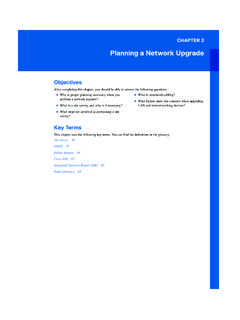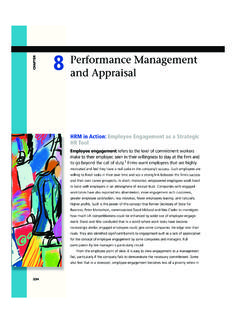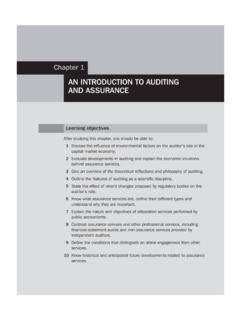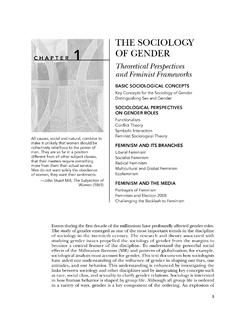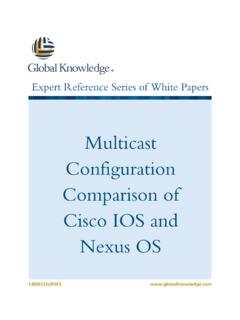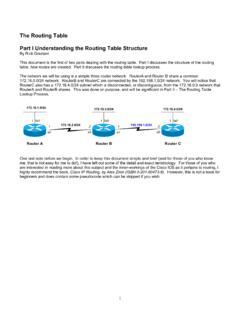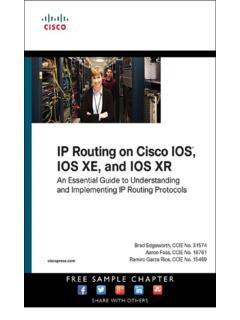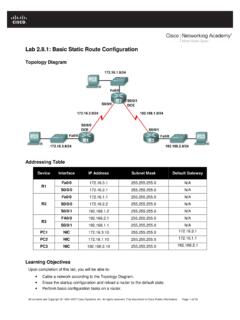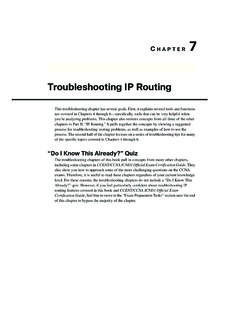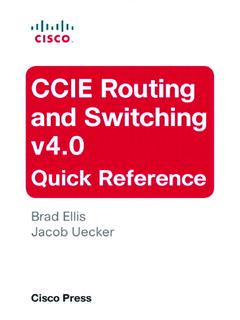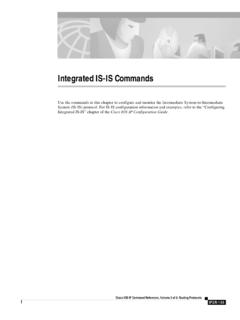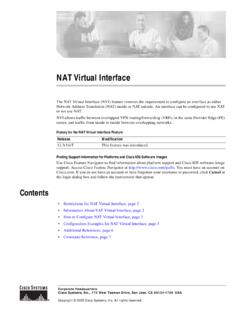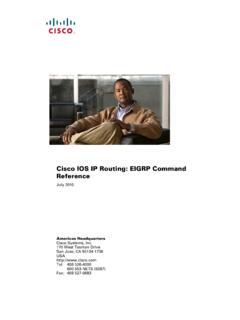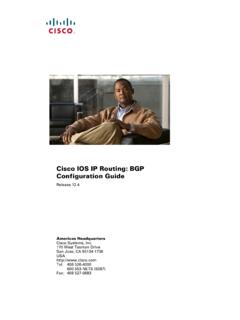Transcription of Chapter 10: Configuring IP Routing Protocols on Cisco Routers
1 Chapter 10: Configuring IP Routing Protocols on Cisco RoutersPage 1 of 59file://J:\NewRiders\chapters\ 10: Configuring IP Routing Protocols on Cisco RoutersThis Chapter discusses the implementation of static and dynamic IP Routing on Cisco Routers in an enterprise network environment. To start, we evaluate route distribution methods and explain the general configuration elements that apply to Configuring dynamic Routing Protocols on Cisco Routers . Then, we review basic steps for Configuring and monitoring IP static Routing , RIP, IGRP, EIGRP, AURP, and OSPF. For easy reference, each section starts with a command summary list and utilizes (whenever possible) the same core network topology (testnet, our example network) illustrated in Figure This Chapter concludes with the implementation of BGPv4 and an overview of IP route best way to learn something is to do it.
2 Therefore, as you did in Chapter 7, "Introduction to Cisco Routers ," you should recreate the configuration examples using a single router or pair of Routers . The section examples revolve around the asbr-a1/2 and asbr-b1/2. Loopback interfaces can be used to simulate additional network interfaces. To create a loopback interface, from global configuration mode, type the following:Router#config tRouter(config)#interface loopback 1 Router(config-if)#Figure testnet network Boston network will use networks with the classful root of , and Albany will use for its IP address space. Classless/VLSM addressing will be used with the Protocols that can support the Right ProtocolThe task of enabling IP route advertisement varies in complexity, depending on the operational scope and size of the network.
3 Static Routing , which is byfar the easiest and most problem-free method, is tedious to manage in large networks and provides no recovery facility when link failures occur. Alternatively, dynamic Routing Protocols address the shortcomings of static Routing , but do, however, come with their own operational , when selecting an IP announcement methodology, there is no single correct answer. There is, however, a wrong answer, which is to select a method that will not be able to meet the networks operational requirements or scale appropriately to enable future growth. The way to avoid this problem is to examine the network s topology, availability, and performance requirements through a series of questions:lWhat kind of network is this (ISP backbone/multipolicy, single GW LAN/WAN, multipoint LAN/WAN, enterprise backbone/single-policy, and so on)?
4 LWhat is the network diameter (more or fewer than 15 hops, how many Routers , and so on)? Chapter 10: Configuring IP Routing Protocols on Cisco RoutersPage 2 of 59file://J:\NewRiders\chapters\ CIDR/VLSM addressing support required?lDoes the network use redundant or multiple paths between network segments?lWhat type of equipment will be used to route traffic on the network, and is a standards-based Routing protocol required?lWhat are the performance requirements of the Routers in the network? For example, is convergence time a factor?After you have a list of requirements, you can review your available options and determine the solution appropriate for your networking environment. Table provides a brief feature comparison of the popular IP Routing options supported on the Cisco Comparison of Routing protocol FeaturesProtocol FeatureRIP v1/v2 IGRPEIGRPOSPFS taticBGPS upports classful addressingyesyesyesyesyesyesInterior Gateway ProtocolyesyesyesyesnonoExterior Gateway ProtocolnononononoyesSupports classless addressingyes (V2)noyesyesyesyesSupports load sharingnoyesyesyesnoyesSupports authenticationyes (v2)noyesyesnoyesEasy implementationyesyesyesnononoRouting algorithmDVDVDUALLS noneDVSupports weighted metricsnoyesyesyesnonoFast convergencenoyesyesyesyesyesUses broadcasts for route updatesyes (v1)yesnonononoUses multicast for Routing updatesyes (v2)
5 NoyesyesnonoSupports large network diametersnonoyesyesyesyesChapter 10: Configuring IP Routing Protocols on Cisco RoutersPage 3 of 59file://J:\NewRiders\chapters\ Vector; LS=Link State; DUAL=Diffusing Update AlgorithmRoute SelectionThe router will use all the available sources of reachability information to construct the most accurate and efficient Routing table possible, based on the available information. Each information source is assigned an administrative distance, which is used to determine a route s integrity. Table lists the IOS s default administrative distance values for its supported IP Routing IOS Administrative DistancesProtocolDistanceConnected interface0 Static route1 EIGRP summary route5 BGP (external)20 EIGRP (internal)90 IGRP100 OSPF110 RIP120 EIGRP (external)170 BGP (internal)200 Unknown255 The lower the administrative distance value, the more trusted the route.
6 So, you can see in situations where multiple Routing Protocols are being used for route advertisement, the router will prefer information provided from certain Protocols over of the big advantages of employing this advertisement hierarchy is that it gives you another way to manage traffic flow in dynamic Routing . By using static routes (which have a lower administrative distance than any dynamic protocol ), you can overrule dynamic announcements in multipath networks to specify the route path to specific hosts. By the same token, it is possible to set a static route to use a higher administrative distance so a dynamic route is preferred and the static route is only used in the event that dynamic route announcement is General Routing InformationThere are several IOS commands used for controlling and displaying information about IP 10: Configuring IP Routing Protocols on Cisco RoutersPage 4 of 59file://J:\NewRiders\chapters\ commands:<show ip route> <show ip route connected> <show ip route [address/hostname]> <show arp> <show ip protocol > <show ip masks> <show ip masks [network address]> <traceroute>Control commands.
7 <clear ip route *> <clear ip route [network] [mask]> <clear arp>Displaying IP Network InformationIn Chapter 7, "Introduction to Cisco Routers ," the <show ip route> user EXEC command was introduced. Now, let s take a closer look at the IOS s route table display:BBR-172#sh ip routeCodes: C - connected, S - static, I - IGRP, R - RIP, M - mobile, B - BGP D - EIGRP, EX - EIGRP external, O - OSPF, IA - OSPF inter area N1 - OSPF NSSA external type 1, N2 - OSPF NSSA external type 2 E1 - OSPF external type 1, E2 - OSPF external type 2, E - EGP i - IS-IS, L1 - IS-IS level-1, L2 - IS-IS level-2, * - candidate default U - per-user static route, o - ODR T - traffic engineered routeGateway of last resort is to network is variably subnetted, 17 subnets, 6 masksS [1/0] via [20/0] via , 6d14hO [1/0] via [1/0] via is directly connected, Serial0/2C is directly connected, Ethernet3/1O IA [110/1563]
8 Via , 4d21h, FastEthernet2/0C is directly connected, Fddi6/0B [20/0] via , 6d14hC is directly connected, Ethernet3/00 [1/0] via [1/0] via is directly connected, FastEthernet2/0S* [1/0] The <show ip route> command output displays all the known network routes and the following information (from left to right):lThe source of the route. The legend for all available Protocols is displayed at the top of the route network and netmask. The netmask can be displayed using bitcount (shown), decimal (default), or hexadecimal. To set the netmask display format, use the <ip netmask-format [format]> command. The command can be used for a temporary <terminal> session Chapter 10: Configuring IP Routing Protocols on Cisco RoutersPage 5 of 59file://J:\NewRiders\chapters\ <terminal ip netmask-format [format]> or used to permanently set the mask format display in configuration EXEC line mode command:router# config tEnter configuration commands, one per line.
9 End with (config)# int vty 0 4router(config-line)#ip netmask-format bit-countRouter(config-line)#^ZRouter#lT he route s administrative distance and Routing network s next hop gateway. If the route is learned dynamically, the route s age or last update time and the interface that the route was learned on may also be gateway of last resort, if one has been in mind that the Routing table displays the best routes, not necessarily all available routes. Only the route with the best administrative distance/metric will appear in the table. In cases where routes of equal cost to the same network are available, both will be listed. Routes to directly connected networks will not appear for disabled interfaces, and neither will static routes that are dependent on the disabled interface.
10 All dynamic Routing Protocols also require that at least one active interface exists and that its address corresponds to a network being announced by the protocol . Although it would seem odd to announce a route for a network that is not active, it is quite common for dial-on-demand and dial access-servers to use network address space on interfaces that are not available all the time. Static routes are usually used to provide reachability information in these situations. An alternative is to use a loopback interface, which acts as a placeholder for the network, and allows it to be announced addition to the basic <show ip route> form of the command, the <show ip route connected>form of the command can be quite useful.

